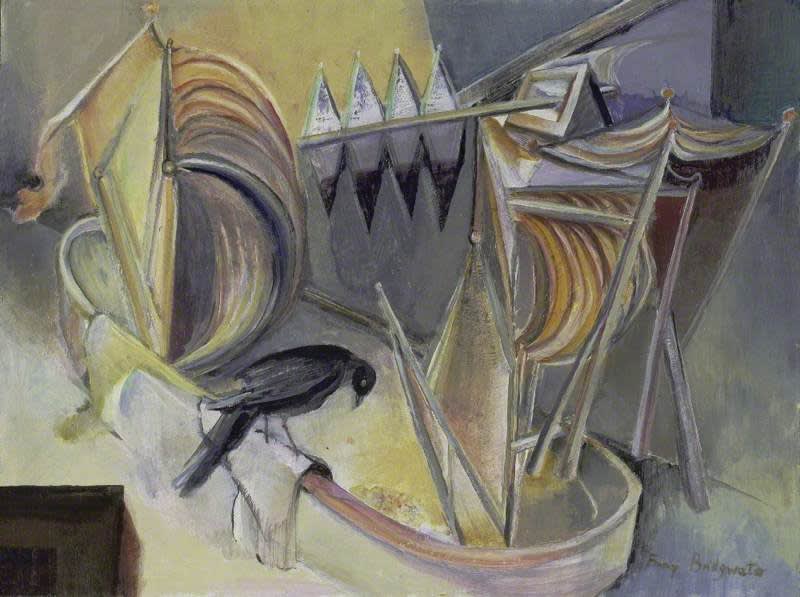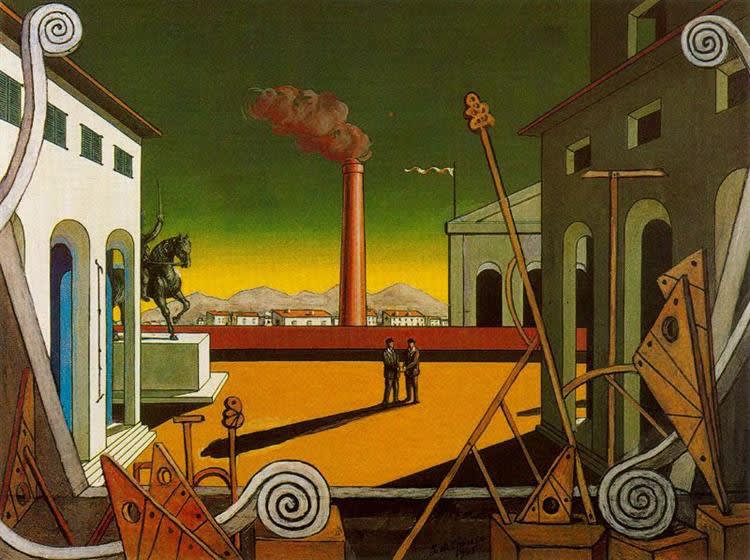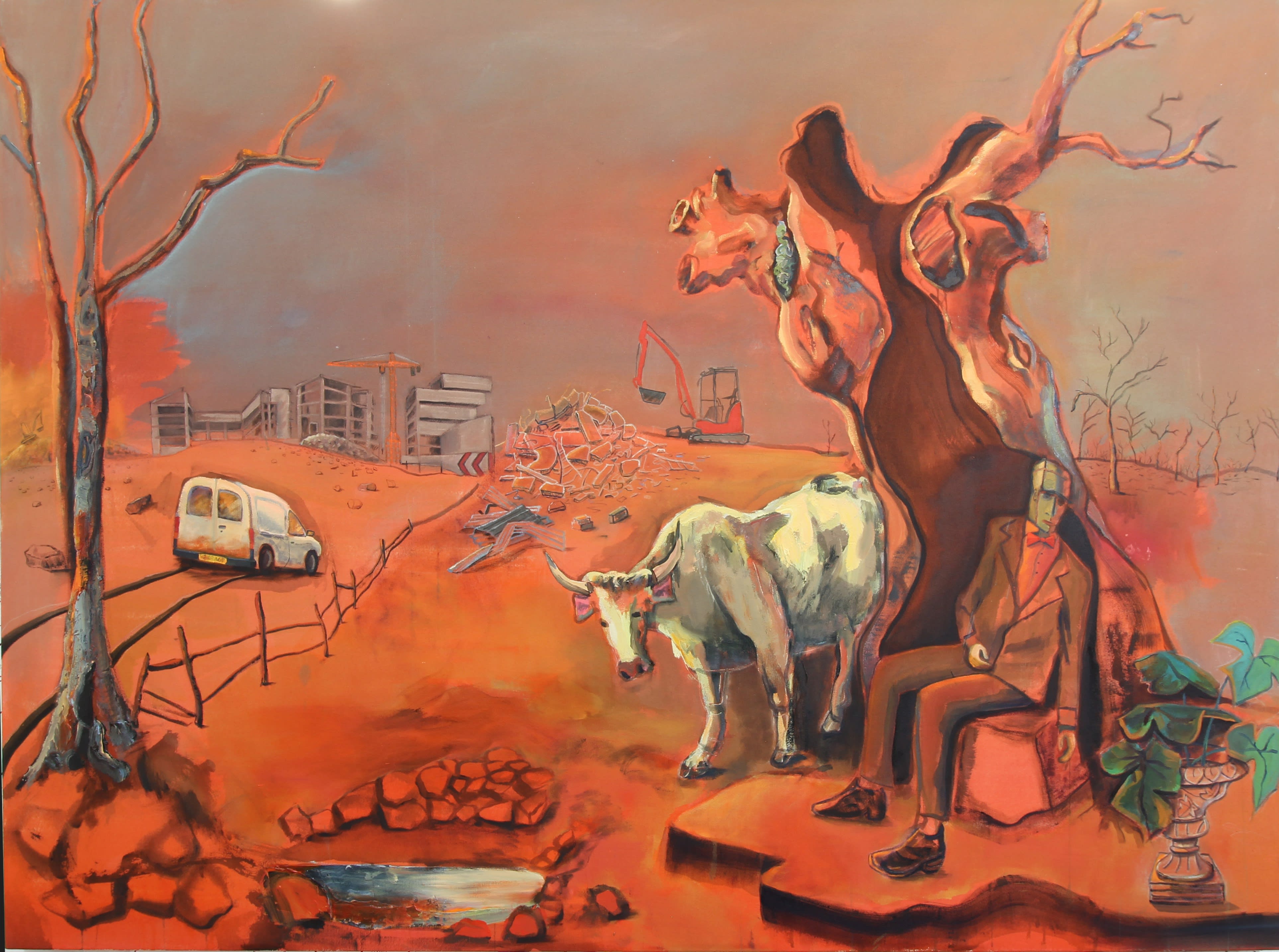
René Magritte, Le Modèle Rouge 1935,
Oil on canvas mounted on cardboard, 56 x 46 cm Centre Georges Pompidou
‘Night work is about to commence’ can be found in the 20th c room of paintings in Birmingham Museum and Art Gallery. It is by Emmy Bridgewater and painted between 1940-43. It depicts an assemblage of shapes and forms that could be located in a period wash room, an iron tub an abstracted clothes mangle and related mechanisms with a mechanical looking crow perched on the tub. There’s a cubist influence in its shape shifting composition and suggestion of imagery in slow flux; it took 3 years of compositional changes for its completion. It can be interpreted as a ship or ghost galleon with the tub and its mast lumbering and sinking down towards the front of the picture plane. The colour scheme, predominately of greys, like soap scrubbed cast iron and yellow and greens evokes a sense of burnished labour in the laundry room. The title evokes a dream journey of the everyday domestic apparatus precariously transforming within a cramped space into a vessel for intended escape.

Emmy Bridgwater ‘Night work is about to commence’ 1940-43 Oil on canvas, Birmingham Museum
Emmy Bridgwater 1906 -1999 was a painter, poet and member of both the Birmingham Surrealists and The London based British Surrealist group. She almost stopped her practice in late 1940’s for nearly 30 years with the care for her elderly mother and disabled sister taking over. Perhaps the along with the struggle of the country at war, the psychology of this burden impending was expressed in ‘Night work is about to commence.’
I stopped and studied this painting on a cold dark wet, November day, (or I’d like to imagine it was, relating to other arresting experiences with paintings in museums at this time of year). I have an over familiarity with Birmingham Museum, as a child excitedly passing through the rooms on the way to see the highlight, a life size model T Rex; and many years later taking groups of students to discuss special exhibitions there. Discovering a previously unrecognised painting is a potent experience and the aroused feelings have significant relationship for me with the context of the subdued salon style museum environment and the re evocation of childhood memories of time and place.
There are aspects of the imagery in Bridgewater’s painting where I’m reminded of the novel ‘The Trial’ by Franz Kafka. Whilst the tone of her painting is not sinister there is certainly a kind of melancholia, a tonal sensibility from the shadowy composite town plaza’s of De Chirico to the pictorial curiosities of Paul Nash’s post First World War landscapes…. This melancholy tone infuses Kafka’s novel with a more sinister edge.
Joseph K wakes up one morning and finds himself under house arrest. He is sure it’s a case of mistaken identity, for a crime he did not commit. Not told the nature of his crimes, he is told to appear at a mysterious court on Sunday, but allowed to continue his regular everyday life, though under close observation…
Set against the background of the social tensions in Austria-Hungary prior to the outbreak of World War, ‘The Trial’ is ‘a prophetic novel that anticipates the insanity of modern bureaucracy and the coming of totalitarianism.’ Kafka died before in 1924 before its completion. What follows in ‘The Trial’ is a series of strange and mysterious events encountered by the protagonist. Given no address Joseph K strangely and instinctively finds the court room, hidden in the attic of a large, slum apartment block. In a bizarre bureaucratic hearing of double talk and word spinning, he receives no progression or further insight to his case or nature of his crime. He decides to return to court the following Sunday, this time in a different location…
The novel spins its tale of the frustrated and haunted journey of Joseph K without progress, wandering the city to different locations, waiting in corridors and entering doors into domestic apartments, into a laundry room, then through the door into another court room. The court room appears in different locations, even through a door behind the bed of a pokey windowless artist’s loft. A strange feeling of sickness often comes over him when he arrives at these locations and his weird encounters with other characters.
There’s another kind of shapeshifting in reference to The Trial’s slippery transitions between contrasting locations through a doors in domestic apartments into court rooms. This is the notion of Superimposition. Both an apartment block and the court room are very real in the matter of fact way Kafka describes them both. There is a familiarity in their evocation. The strange unexpected but casual slippage between these locations, just through a door, generates a sense of an uncertainty and of the Uncanny. The slippage back and forth between these places, the return and repetition amplifies this effect.
The painter Magritte utilises a form of Superimposition. His painting, ‘Red Model’ (1935) for example depicts the morphing of the leather boots into human toes. It is also arguably an uncanny image due to the paradoxical closeness, yet unnaturalness of the relationship between the two elements.
A Superimposition can be described where two separate elements or entities, which are familiar of their own terms are joined together to create something unfamiliar, unexpected, or disconcerting. This meeting point between the two, the superimposition is also where an element of the uncanny can lie. The Uncanny, first explored by Ernst Jentsch in a 1906 essay and by Freud’s more famous essay in 1924.
Jentsch defines the Uncanny as: being a product of ‘...intellectual uncertainty; so that the uncanny would always, as it were, be something one does not know one’s way about in. The better oriented in his environment a person is, the less readily will he get the impression of something uncanny in regard to the objects and events in it.’
The sense of spatial disorientation within the text of the Trial links to back to Bridgwater’s ‘Night work’; which contains mutability between form and suggested location; washroom apparatus forming into a ship and sailing through the cramped ocean of that room.
Emmy Bridgwater’s cubist style inspired my own series of mixed media works called ‘Interior studies’. In these works imaginary semi abstract landscapes are framed in a wooden box with an irregular hand cut shelf with an object, made from materials ranging from clay shells, wood and mirror tile, placed on it. I had previously begun producing abstract landscape pictures that were also inspired by the landscapes of Paul Nash. Noticing one day one of these studies propped up in my studio and an unrelated piece of clay doodle in front of it; I became curious of the relationship between the two. The ply wood frame offered a linking device. I then assumed it as a kind of model for a stage set, the painting the backdrop, the frame the stage and the object a prop or even performer on the stage. It created a link to another element of my work, performance, which in turn reflected back to painting and figure ground relationships. There is also a connection to De Chirico, some of his paintings, as well as being seeped in the same sinister melancholia also found in Kafka’s Trial, also allude to improvised stage sets, for example in a late work, ‘The Great Game’ (1971).

Paul Newman ‘Interior study vii’ 2013 Water, colour ink, wood, card and plastic mirror

Giorgio de Chirico ‘The Great Game’ 1971 Oil on canvas, Private Collection
‘Stage’ a solo exhibition curated by Craig Ashley at mac Birmingham 2015 was a retrospective of painting, film and collage based installation exploring the relationship between the studio space where art is made and the exhibition space. There is a reference to the writing of Brian Odoherty; ‘The Studio & the Cube 2007’ a follow up to his own ‘Inside The White Cube’, 1976.
The title ‘The Stage’ was a nod to the performance element of my work including re-presentations and documents of some of these works, for example; ‘The Last Day 2012.’ Originally a live studio performance and later a stop motion animation that was presented in ‘Stage’ both on a monitor in the exhibition space and as an excerpt in the cinema before screenings, it also exists as a limited edition photographic print. ‘The Last Day’ depicts both a factual and staged image of my studio space with the colourful detritus from my painting and various props from previous work crowding in. Wearing a performance costume from a durational performance called ‘A Confidentiality Clause’ originally performed in 2005, the submerged white gloved character wears a giant sugar cube for a head and is constantly stirring or sipping a cup of tea.

Paul Newman ‘The Last Day’ Digital C-Type print on Kodak Endura on a Chromira
The original 2005 performance was inspired by the contrariness and absurdity of encounters in Lewis Carols’s ‘Alice’s Adventures in Wonderland’. It also featured a tonally different and austere wrap around sequence designed with my collaborator at the time, Arlene Burnett. We engineered an official waiting room and formal signing of documents before the audience individually entered the special room. They would not reveal afterwards any details their encounter. Incidentally this bureaucratic sequence was inspired in part by Kafka’s; ‘The Trial.’
‘The Last Day’ as an image features elements of my painting and its colour, form and concentrated version of my studio represents a bridge between the photograph and the painting. The crowding of stuff relates to influences from the type of imagery and clutter in paintings like Emmy Bridgwater’s ‘Night work.’
The studio is important in other ways and links back to my original description of the encounter with Emmy Bridgwater’s painting in the Birmingham Museum. I had a comparable experience a few years earlier in the Sackler Room in the National Gallery. Again ducking out of the damp late day gloom I was transfixed in front of Constable’s ‘Salisbury Cathedral from the Meadows’ 1831, captivated by it’s silvery psychological storm, a potent cocktail in the context of its salon surroundings. Years later with literally a blank canvas in my studio I pulled out the postcard I bought of the painting and handling this tactile card I was taken back to this recollection in the National Gallery and instinctively started a version of it called ‘Golden Years; studio painting’ 2011. The abstract dark matter merging in from the left was intuitively a representation of the amassing of stuff and daubed mark making on my studio walls. Wrestling with how to complete the foreground I glued muscle shells with paint onto the picture surface. This instinctive move was inspired partly by misremembering the details of a conversation with colleague and painting expert at the School of Art in Birmingham who described how plein air painters from the Romantic era period used shells to mix their paint in.

Paul Newman ‘Golden Years; studio painting’, 2012 Acrylic, and shells on canvas
The appropriation of historical landscape painting provides a backdrop for a recent series of work under the umbrella English Gothic 2016-present which combine elements of 20th Century urban and architectural motifs. The paintings look back as well as into future dereliction with characters including a version of Frankenstein’s Monster surveying, wading through or resting in a turbulent landscape but never reaching their destination. In ‘Something in the Water’, 2019 Frank is resting against a tree from Gainsborough’s Woodcutter & the Maid 1775 in a depleted Mars like landscapscape with a 21st c demolition of Birmingham’s 20th c architectural heritage on the horizon.

Paul Newman ‘Something in the Water’ 2019 Acrylic on canvas
Distorted memories, the re-evocation of time, place and repetition of experience are prevalent to the index of day to day movements within our own micro environments. The awkward navigation in the Emmy Bridgwater’s painting ‘Night work is about to commence’ and by Joseph K in Kafka’s ‘The Trial’ evokes both a labyrinth and a cul-de-sac of uncertainty an individual’s journey.
“Perhaps my life is nothing but an image of this kind; perhaps I am doomed to retrace my steps under the illusion that I am exploring, doomed to try and learn what I simply should recognize, learning a mere fraction of what I have forgotten.”
― André Breton
Paul Newman February 2020

